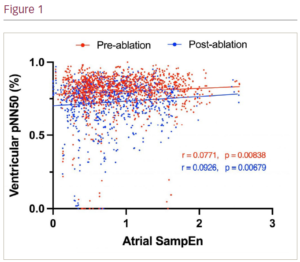Background: Atrial fibrillation (AF) is characterised by an irregularly irregular ventricular rhythm. However, an understanding of the mechanisms by which the regularity of ventricular response is influenced by AF dynamics is still lacking. In AF, atrial electrical activity can have different levels of organisation on a spectrum, from organised AF sustained by focal drivers through to disorganised AF sustained by multiple wavelet re-entry. We aimed to investigate whether the ventricular response in AF was associated with the organisation of atrial electrical activity, with the hypothesis that AF organisation correlates with ventricular response regularity.
Methods: Data from 239 patients with persistent AF undergoing pulmonary vein isolation (PVI) were retrospectively reviewed. AF organisation and measures of ventricular variability and irregularity were evaluated in 50-second segments in each patient before and after ablation. AF organisation was assessed using Shannon entropy (ShEn) and Sample entropy (SampEn) of coronary sinus (CS) atrial electrograms. Ventricular variability and irregularity were evaluated using RR interval (RRI) metrics derived from the surface electrocardiogram (ECG). RRI variability was evaluated using the time-domain measures: normalised mean RRI difference, standard deviation of RRIs (SD RRI), normalised SD RRI, root mean square of successive RRI differences (rMSSD) and percentage of successive RR intervals that differ from each other by more than 50 ms (pNN50). RRI irregularity was measured using SampEn and normalised SampEn.
Results: A significant decrease in atrial ShEn and SampEn was observed following PVI across all CS channels (e.g. SampEn CS 3-4: pre-ablation 0.907 ± 0.512 vs post-ablation 0.790 ± 0.447; p<0.0001). Both ShEn and SampEn from CS atrial electrograms were significantly correlated with the RRI variability and irregularity measures from surface ECG (pNN50, normalised mean RRI difference, normalised SD RRI and normalised SampEn) both pre- and post-ablation (pNN50: r=0.0771, p=0.00838 [Figure 1]; normalised mean RRI difference: r=0.144, p<0.0001; normalised SD RRI: r=0.175, p<0.0001; normalised SampEn: r=0.168, p<0.0001; correlations with SampEn CS 3-4 pre-ablation shown).
Conclusions: The reduction in atrial ShEn and SampEn following PVI suggests that PVI is accompanied by an increase in AF organisation. The significant correlations between atrial entropy and measures of RRI variability and irregularity suggest that AF organisation impacts ventricular response regularity. Therefore, interpretation of the RRI variability and irregularity from the surface ECG may give some insight, non-invasively, into the level of AF organisation. ❑















